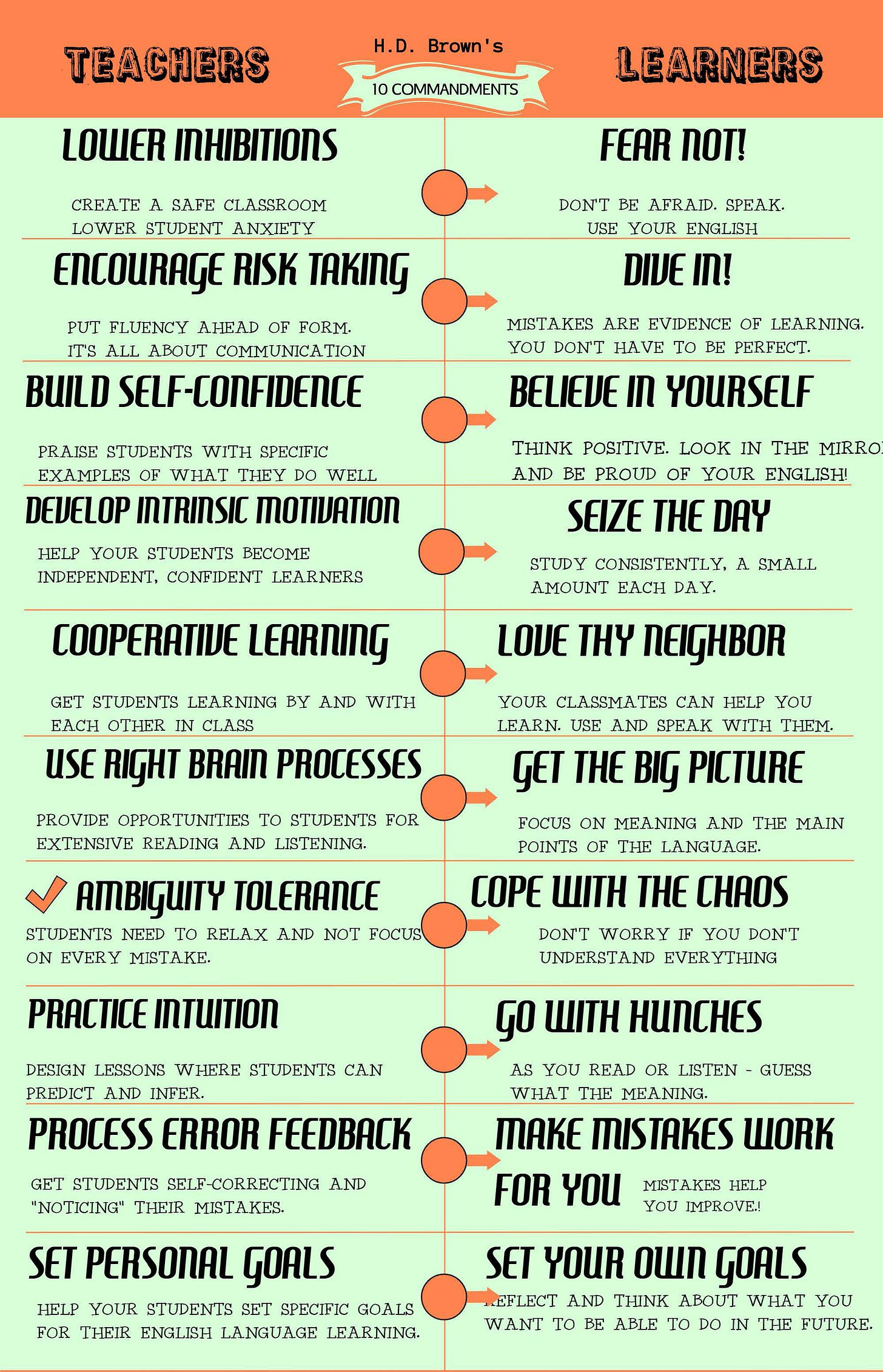Brown's 10 Commandments
10 things both teachers and students should consider in order to do their best as language teachers and learners.
Linkedin | Videos | Blog | Printables | ELT News | TpTs | Youtube Channel
Download the PDF poster »> Do you know all our professional development materials are free for members? Take a look.
The 10 Commandments For Teachers And Learners. H.D. Brown
In his important book - Principles of Language Learning and Teaching, H. Douglas Brown offered up 10 commandments that both teachers and learners should follow. Here are the 10 things teachers should focus on when teaching a language and their corresponding counterpart for student focus. Think about these tips - do you operate with them in mind, in your own day to day teaching?
1. Lower Inhibitions. Fear Not! Teachers need to create a safe environment for their students. A classroom they feel comfortable in and relaxed about practicing the forms of language. A place where everyone encourages one another and mistakes are just evidence of learning. Students need to train themselves to deal with ambiguity tolerance (not feeling anxious if they don't know exactly what a speaker means) and trust their own abilities more by just trying to communicate without an over focus on form and being 100% correct.
2. Encourage Risk Taking. Dive In. Teachers need to help students take the steps necessary to engage with the language and not be afraid to experiment, be correct every single utterance. On the flip side, students just need to "dive in" and immerse themselves in language, learn language implicitly and through exposure.
3. Build Self-Confidence. Believe In Yourself. A large part of any teacher's job description is filled with the need to be a psychologist and motivational expert. Teacher's need to believe their students can succeed - a teacher's own expectations is very closely tied to student achievement. It's essential students believe in their own abilities. Students who don't believe in their own ability to learn will become victims to their own self-fulfilling prophecy.
4. Develop Intrinsic Motivation. Seize The Day. Teachers are motivational specialists. They do little things to keep students engaged, excited and motivated. However, if they can turn on students' intrinsic motivation, a love of learning in and of itself, so much the better. Students in turn need to take advantage of the opportunities afforded by classroom teachers and their classmates.
5. Cooperative Learning. Love Thy Neighbor. A classroom is a playground where a team performs. It is essential that teachers build classroom atmosphere and identity. Learning a language is also a social process, so lessons should be designed to foster cooperative learning and allow students to learn together and learn from each other. Conversely, students need to realize that classmates are great facilitators and helpers in that they offer opportunities to practice, share and construct knowledge together.
6. Use Right Brain Processes. Get The Big Picture. Learning a language is essentially one of acquisition and implicit learning. Turn on the right brain and take in the big picture. Large amount of input at the right level for understanding (zone of proximal development) is needed. A focus on form can be helpful but it is the seasoning not the main dish. Students need to focus on meaning and meaning making. Just understand the overall meaning, no need to understand each and every word or grammatical form.
7. Ambiguity Tolerance. Cope With The Chaos. Teachers can present listening and reading that promotes top-down processing. Understanding the gist and processing meaning. Students need to get better and better at ignoring what they don't understand so long as they understand the main idea. Over time, they'll become better at the specifics and bottom up processing of language.
8. Practice Intuition. Go With Hunches. Teaching is an art, a skill and not a science. Teachers do things that their gut tells them is right for their students in the here and now. Students also, have to go with the flow of communication and not get stuck in the small details of linguistic competence.
9. Process Error Feedback. Make Mistakes Your Friend. Teachers need to get students noticing their errors and being aware of what they need to work on, improve on. Students on the other hand need to realize that mistakes are evidence of learning and not bad things. Nor, do learners learn mistakes - mistakes are just part of the process of our language learning journey.
10. Set Goals. Both teachers and students should set goals for themselves. It's how we improve, by having a target to reach for and monitoring our progress towards that target. It's also highly motivating.
Which of these do you think you might work on more and improve? Choose one to focus on and set some goals to monitor your improvement.
See our lesson materials about the 10 Commandments here.



It's stood the test of time. But yes, nothing but bears repeating these days when teaching is so less understood as the humanistic encounter and act that it is.
Bad title: very authoritarian. All this has been said before, in many places so nothing new or astonishing.